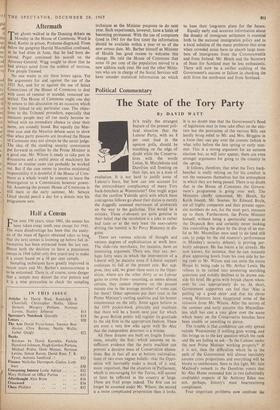Half a Census
FOR over 150 years, since 1801, the census has been taken every tenth year except for 1941. The main disadvantage has been that the analy- sis of the mass of figures obtained takes so long. that the next census is looming up before full in-'
has been extracted from the last one. Hence both the decision to have a population census in 1966 (after only five years) and to make it a count based on a 10 per cent sample.
Sampling techniques have greatly improved in recent years and Mr. Barber's announcement is to be welcomed. There is, of course, some danger that a sample may distort the true pattern and it is a wise precaution to check the sampling
technique as the Minister proposes to do next year. Such experiments, however, have a habit of becoming permanent. With the use of computers (used in 1961 for the first time) the information should be available within a year or so of the new census date. Mr. Barber himself as Minister of Health has good reason to welcome this change. He told the House of Commons that some 10 per cent of the population moved to a new address each year. He and the other Minis- ters who are in charge of the Social Services will have sounder statistical information on which
to base their long-term plans for the future.
Equally early and accurate information about the density of immigrant settlement is essential both to the national immigration policy and to a local solution of the many problems that arise when crowded areas have to absorb large num- bers of immigrants from the Commonwealth and from Ireland. Mr. Heath and the Secretary of State for Scotland may be less enthusiastic. There will now be a swifter auditing of the Government's success or failure in checking the drift from the north-east and from Scotland.






























 Previous page
Previous page